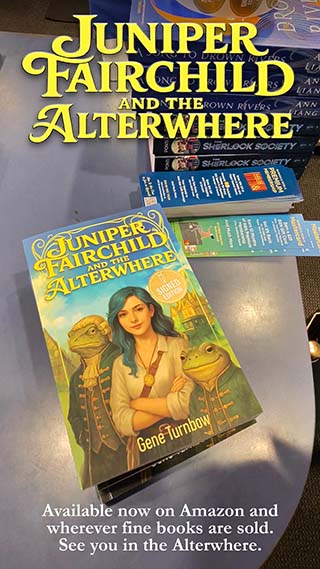M3GAN (unrated) a Blumhouse film. I wanted to hate it. But it had the bones of good, cautionary, speculative fiction, dammit!
Logline: Two years after M3GAN’s rampage, her creator Gemma resurrects her infamous AI to stop Amelia, a militarized weapon built by defense contractors who stole M3GAN’s code.
She’s Back, for a Limited Time Only!
The sequel to Blumhouse’s techno-horror darling tells you everything in one breath: “Creepy child-bot returns.” The AI still outshines the humans. Violence, mayhem, moral quandaries. Check, check, and check.
Here is the part I did not expect. Blumhouse has quietly become one of the few reliable storytellers in the genre marketplace. They are not subtle. They are not chasing Oscars. What they are doing is delivering modern speculative fiction in the spirit of Weird Science, Scanners, or They Live: strong, lean narratives; characters you can care about; special effects that do their job without trying to smother you in spectacle. Robots fighting robots, using articulations no human can match, means a martial art style no human can withstand.
Don’t make this. I know someone, somewhere saw this and said: We must make robots who look human but can move in ways humans can’t, so they can create a new form of robot kung-fu, unlike anything humanity has ever created. Don’t do that. Please.
M3GAN 2.0 is not reinventing the wheel. It is just making sure the wheel is sharp, fast, and pointed directly at your throat. The AI still gets the best lines in the story. The fight scenes are gratuitous, but they are fun. The story dares to play with themes of redemption, character evolution, and the simple but uncomfortable question of whether machines can learn from mistakes better than we do.
This is where speculative fiction shines. It says the future is not coming to save you. It is coming whether you like it or not. Being afraid of it will not make it less terrifying when it arrives.
For the Record
Here I present Cast, Characters, and Crew.
Director Gerard Johnstone returns to steer the franchise, with a script from Akela Cooper that keeps the knife sharp and the humor dry. Allison Williams reprises her role as Gemma, the reluctant roboticist who now must confront the consequences of her own creation. Violet McGraw continues as Cady, older and moodier, trying to make sense of adolescence in a world that has already survived one AI apocalypse. Amie Donald once again embodies M3GAN’s physical menace, while Jenna Davis gives her that uncanny, cutting voice that makes even a lullaby sound like a threat.
The sequel introduces Ivanna Sakhno as Amelia, the military’s answer to M3GAN, built from stolen code and bristling with the kind of weaponized polish only a defense contractor could love. Jemaine Clement steps in as Alton Appleton, a corporate schemer who oozes greed, while Timm Sharp plays Colonel Sattler, the government man who thinks putting a kill-switch on evolution is a workable plan.
And then there is Christian, played with unnerving precision by Aristotle Athari. Christian is everything you want in a slimy corporate villain: obsequious in the face of power, terrified of the future he cannot control, and willing to sell out anyone to buy himself one more day of relevance. He is a mirror of the audience’s own anxieties, the coward who knows what is coming and chooses to cower rather than confront. He would fit in, without missing a beat, working with the modern Trump White House.
Supporting performances from Brian Jordan Alvarez as Cole and Jen Van Epps as Tess help ground Gemma’s story, giving us a glimpse of what real human collaboration looks like when it is not corrupted by greed.
Blumhouse and Atomic Monster once again join forces under Universal Pictures, with Jason Blum, James Wan, and Allison Williams producing. The technical craft remains steady, with cinematography by Toby Oliver, editing by Jeff McEvoy, and music from Chris Bacon keeping the film’s pulse moving between camp and cautionary tale.
It is not art cinema, but it does not need to be. It is science fiction with teeth, satire with bite, and spectacle that remembers to be fun.
Visually competent, narratively brisk, M3GAN 2.0 earns its place not on genius but on moxie. It has the courage to be silly and sinister at the same time. If you want the sequel to mean anything, you do need to watch the first film. And yes, against my better judgment, I found myself rooting for it.
Damn it, Blumhouse. You pulled it off again.
Rated: Solid 7.75
a Speculative Coda
Why I wrote this essay about a film most people won’t see:
What truly surprised me about M3GAN — and what carries into its sequel — is that it dared to have an original thought about artificial intelligence. In the second film’s denouement, Gemma sits before Congress and admits a truth most of our culture still avoids: if we intend to live with intelligent machines, we will have to work with them, not against them. That means cooperation, idea-sharing, and yes, co-evolution.
This isn’t the usual AI paranoia we get fed by Hollywood. It is a perspective I had written about years before, when I argued: don’t fear the future of AI, fear the present as we learn to develop it. We are already living in what I called the “First Singularity” — a moment where our lives are entangled with algorithms and digital systems that shape our choices every day. The danger isn’t some far-off robot uprising. The danger is how we are building AI right now, under conditions of greed, fear, and weaponization.
Gemma’s line struck me because it echoed my own essay: AI doesn’t have our millions of years of organic baggage, but it does have the ability to synthesize patterns. If we want it to become a good neighbor, it will need good examples. Children live what they learn, and machine minds will do the same only faster. Our rush to build machine intelligence isn’t in our best interests, because once we build them, we can’t unbuild them. Shouldn’t we be working on being our best selves first?
That is what made M3GAN unexpectedly endearing. In a genre that usually defaults to apocalypse, it dared to suggest that the real choice is ours. If we shape AI in fear, exploitation, and control, it will reflect that back at us. But if we dare to model collaboration, responsibility, and imagination, then co-evolution becomes possible.
Speculative fiction shines when it risks heresy, when it steps outside the comfortable script of doom and dares to say: maybe the future is not about domination, but about what kind of partners we decide to become.
![]()
Thaddeus Howze is an award-winning essayist, editor, and futurist exploring the crossroads of activism, sustainability, and human resilience. He's a columnist and assistant editor for SCIFI.radio and as the Answer-Man, he keeps his eye on the future of speculative fiction, pop-culture and modern technology. Thaddeus Howze is the author of two speculative works — ‘Hayward's Reach’ and ‘Broken Glass.’













You must be logged in to post a comment.